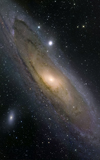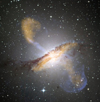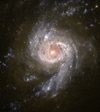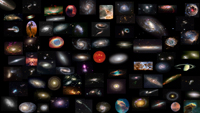Chapter 3: Galaxies
The Galaxies chapter contains six segments:
- Andromeda and the Local Group
- Local Galaxy Volume
- Virgo Supercluster
- Local Superclusters
- Colliding Galaxies
- Cosmos
 Andromeda and the Local Group starts with Edwin Hubble’s discovery of the Cepheid Variable star V1 in Andromeda and proved that it was well outside the Milky Way. We take a good look at the Andromeda galaxy including its central supermassive black hole. We then take a tour of the galaxies in the Local Group including Triangulum. We then focus on the Large and Small Magellanic cloud galaxies orbiting the Milky Way. We take a look at some of the nebula inside these dwarf galaxies.
Andromeda and the Local Group starts with Edwin Hubble’s discovery of the Cepheid Variable star V1 in Andromeda and proved that it was well outside the Milky Way. We take a good look at the Andromeda galaxy including its central supermassive black hole. We then take a tour of the galaxies in the Local Group including Triangulum. We then focus on the Large and Small Magellanic cloud galaxies orbiting the Milky Way. We take a look at some of the nebula inside these dwarf galaxies.
In the Local Galaxy Volume we  use the Spitzer Team’s deep look into galaxies within 36 million light years. Being relatively close, the photographs of these galaxies are rather stunning. We end with a look at the tuning fork diagram created by Edwin Hubble with its description of spiral, elliptical, lenticular and irregular galaxies.
use the Spitzer Team’s deep look into galaxies within 36 million light years. Being relatively close, the photographs of these galaxies are rather stunning. We end with a look at the tuning fork diagram created by Edwin Hubble with its description of spiral, elliptical, lenticular and irregular galaxies.
The Virgo Supercluster segment covers the galaxies in our local supercluster. It shows our Milky Way’s place in it, its vast size, and its structure. For the first time, we see that galaxies form into galaxy groups and galaxy groups form into galaxy clouds. Here is where we formulate Hubble’s Law and add Red Shift to our distance ladder.
covers the galaxies in our local supercluster. It shows our Milky Way’s place in it, its vast size, and its structure. For the first time, we see that galaxies form into galaxy groups and galaxy groups form into galaxy clouds. Here is where we formulate Hubble’s Law and add Red Shift to our distance ladder.
The Local Superclusters segment  covers around 7% of the visible Universe. Here we are at a distance where we can see that even superclusters interact with each other to form walls of galaxies. We take a tour of galaxies within the nearest superclusters and beyond. We end with a grand view that shows our entire Galaxy Volume as a dot.
covers around 7% of the visible Universe. Here we are at a distance where we can see that even superclusters interact with each other to form walls of galaxies. We take a tour of galaxies within the nearest superclusters and beyond. We end with a grand view that shows our entire Galaxy Volume as a dot.
![]() In Colliding Galaxies, we begin with the evidence for the collision between Andromeda and the Milky Way. We explain what it means for galaxies to collide. Then we show some of the amazing interacting galaxies photographed by Hubble. We then explain the billion year multi-phase process for a collision and show various galaxy collisions in each these phases. We conclude with a computer simulation of the Andromeda – Milky Way collision.
In Colliding Galaxies, we begin with the evidence for the collision between Andromeda and the Milky Way. We explain what it means for galaxies to collide. Then we show some of the amazing interacting galaxies photographed by Hubble. We then explain the billion year multi-phase process for a collision and show various galaxy collisions in each these phases. We conclude with a computer simulation of the Andromeda – Milky Way collision.
 In our final segment on the Cosmos, we go well beyond the distances covered in our Local Superclusters. With the Hubble Ultra Deep Field view, we reach back to the most distant galaxies in existence. We take a look at galaxy collisions that provide evidence for Dark Matter. We describe the expansion of the Universe as the stretching of space and look at some Type 1a Supernova that indicate that the expansion of the Universe is accelerating. This leads directly to the idea of Dark Energy. We then review recent massive surveys of galaxies out to billions of years and show a 3D computer simulation of the Cosmos as we currently understand it. We end with a look at the next generation space telescope and the questions we hope it will answer. The last scene is Edwin Hubble’s own words on the limits of our knowledge.
In our final segment on the Cosmos, we go well beyond the distances covered in our Local Superclusters. With the Hubble Ultra Deep Field view, we reach back to the most distant galaxies in existence. We take a look at galaxy collisions that provide evidence for Dark Matter. We describe the expansion of the Universe as the stretching of space and look at some Type 1a Supernova that indicate that the expansion of the Universe is accelerating. This leads directly to the idea of Dark Energy. We then review recent massive surveys of galaxies out to billions of years and show a 3D computer simulation of the Cosmos as we currently understand it. We end with a look at the next generation space telescope and the questions we hope it will answer. The last scene is Edwin Hubble’s own words on the limits of our knowledge.